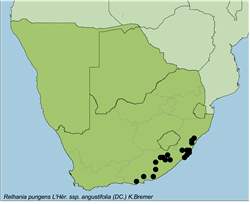Names and synonyms
Relhania pungens L'Herit. ssp. angustifolia (DC.) Bremer=Eclopes parallelinervis Less. var. �. angustifolia DC. =Relhania pungens L'H�r. p.p.
Type
Drege, J.F. 4993, Zw. Omsamwubo und Omsamcaba, South Africa, 1832-05-15 (P)
Derivation of names
Relhania = after Irish-born Richard Relhan (1754-1823), botanist, plant collector, bryologist, lichenologist, one of the founders of the Linnean Society, rector in Lincolnshire and author of Flora Cantabile.pungens = with sharp pointsangustifolia = with narrow leaves
Diagnostic characters
Often a suffrutex with a tuft of new branches sprouting after a fire, becoming a sparsely branched or straggly shrub later onUpper limb of involucral bracts membranous, acute Capitula mostly solitary, occasionally in clusters of 3 or more
Description
A sparsely branched shrublet or suffrutex, 0.3-0.5 m tall. Stems ascending-erect, tomentose, leafy, becoming glabrous and nude and marked with leaf-scars. Leaves 8-25 x 0.5-5 mm, usually linear or sometimes lanceolate or narrowly elliptic, coriaceous and sometimes somewhat rigid, distinctly 3-9-nerved with closely parallel to widely spaced nerves, usually tomentose with deciduous indumentum or occasionally glabrous dorsally, densely lanate and whitish above, acute. Capitula solitary, sessile, terminal. Involucre 6-18 mm wide, bell-shaped. Involucral bracts 25-60, outer ovate, inner gradually longer with a spreading apical limb, glabrous or dorsally tomentose and whitish. Receptacle flat-convex, paleate. Paleae canaliculate, subulate, entire or slightly and irregularly serrate, 5.5-10 x 0.4-0.8 mm, acute-acuminate, persistent. Ray florets 15-30, tube somewhat triquetrous, 2.5-5 mm long, lamina narrowly elliptic-oblong, 6.5-14 x 1.5-2.7 mm, 4- or occasionally 5-6-veined. Disc florets 25-100, perfect. Pappus crownlike, of � connate scales, up to 1.9 mm long. Cypsela flat with inner edge often winged, elliptic-oblong-oblong, 1.9-3.5 x 0.6-1.2 mm wide, glabrous or shortly hispid-pilose with longer hairs on lateral ribs.
Flowering time
Mainly from October to February.
Distribution
Ssp. angustifolia is found from King Williamstown and East London to Drakensberg and Durban.It is known from more than 25 specimens.
Habitat
Dry areas near streams and on plateaus on top of mountains, rocky outcrops in coastal grassland, steep slopes, sandstone and grassland areas.
Notes
This is a variable species, composed of three subspecies, which look quite different from each other. Their leaves have many nerves and are always densely lanate above, which distinguish them from R. calycina and R. speciosa.The shape and venation of the leaves are the most important varying characters. Others are the shape of the involucral bracts and the size of the capitula with the floral parts.Although three subspecies are distinguished, the boundaries between them are not exactly defined and there will be specimens that are difficult to place.
Key to the subspecies 1a Leaves linear -lanceolate, with closely parallel nerves; the nerves not separated more than the width of the nerves themselves ......................................................................... 21b Leaves narrowly elliptic, with widely spaced nerves; the nerves separated more than the width of the nerves themselves ............................................................................ ssp. trinervis 2a Leaves hard and rigid, pungent, usually glabrous dorsally............................... ssp. pungens 2b Leaves � soft, acute, but not pungent, usually tomentose with deciduous indumentums dorsally ................................................................................................................. ssp. angustifolia
References
BREMER, K. 1976. The genus Relhania (Compositae). Opera Botanica 40. GLEN, H.F. 2004. SAPPI, What's in a Name? The Meanings of the Botanical Names of Trees. Jacana.HILLIARD, O.M. 1977. Compositae in Natal. University of Natal Press.KESTING, D. & CLARKE, H. 2008. Botanical names, what they mean. Wild Flowers of the Cape Peninsula, 3rd revised edition. Friends of Silvermine.
